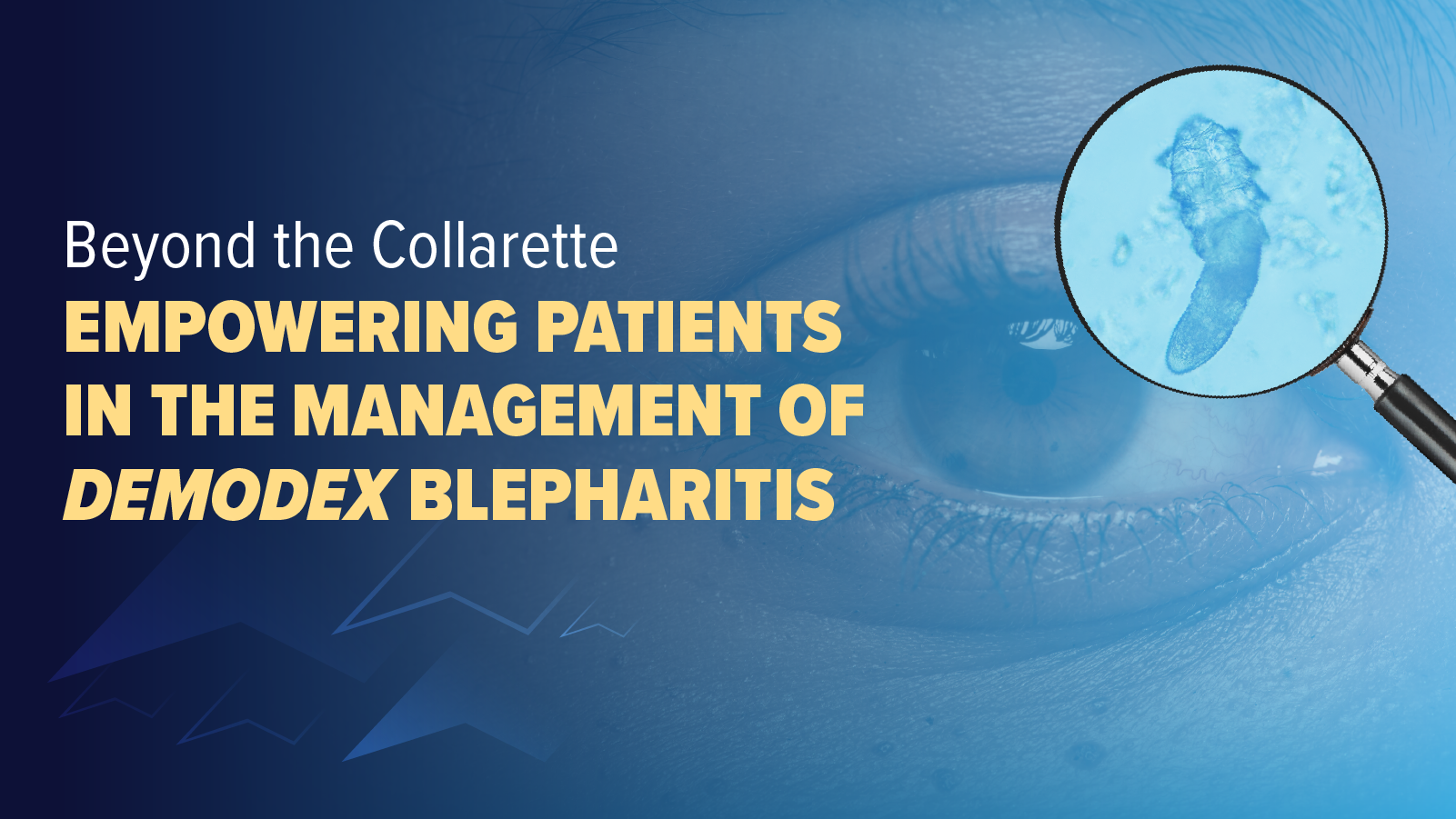
- Contagion, Spring 2025 Digital Edition
- Volume 10
- Issue 1
Ocular Syphilis and Neurosyphilis in a Patient Living With HIV
Final diagnosis
Ocular syphilis and concurrent neurosyphilis
History of the Present Illness
A 50-year-old man with a medical history notable for HIV/AIDS and a history of previously treated neurosyphilis presented with acute on chronic bilateral visual changes. The patient was in his usual state of health until 6 months prior to admission, when he developed the gradual onset of bilateral nonpainful blurry vision that lasted for several weeks and spontaneously resolved without intervention. One month prior to admission he had recurrence of bilateral nonpainful blurry vision. The blurriness of both eyes progressed, with the right eye becoming worse than the left 1 week prior to his presentation. On the day of admission, he awoke with significant worsening of the bilateral vision, with the right still worse than the left, which prevented his ability to manage his activities of daily living. He presented to the emergency department for evaluation. He described fogginess throughout his visual field such that only colors could be discerned, associated with black dots throughout the visual field. He denied eye or orbital pain but reported an associated headache centered frontally with temporal extension bilaterally, which he had not experienced previously. He denied fever, chills, night sweats, hearing changes, neck pain, change in motor function or sensation, or gait changes. He denied photosensitivity or phonophobia. He denied recent skin or mucosal lesions including oral or genital lesions. The rest of his review of systems was negative.
Medical History
The patient’s history was most notable for AIDS/HIV, which was diagnosed 10 years prior with CD4 count nadir of 10 cells/μL (reference range, > 500 cells/μL). The patient was concurrently diagnosed with and treated for neurosyphilis with intravenous (IV) aqueous penicillin 4 million units every 4 hours for 14 days. The cerebrospinal fluid (CSF) Venereal Disease Research Laboratory (VDRL) test was 1:1 at time of diagnosis and nonreactive on repeat about 5 years prior to the current admission.
Key Medications
He was prescribed oral bictegravir 50 mg, emtricitabine 200 mg, tenofovir alafenamide 25 mg, trimethoprim 800 mg, and sulfamethoxazole 160 mg daily, though he had intermittent access to them over the prior year.
Epidemiological History
On initial history, the patient reported being sexually active with men but was last active prior to HIV diagnosis. He noted a history of rectal use of methamphetamines with an unclear last use and a remote history of IV methamphetamine use. He was experiencing housing instability. He denied having any pets.
Physical Examination
The patient was not in acute distress. His vital signs demonstrated temperature of 97.9 °F; blood pressure 100/65 mm Hg; heart rate of 95 beats per minute; and oxygen saturation 97% on room air. His bilateral pupils were dilated due to recent ophthalmologic evaluation without scleral injection, or scleral icterus. His oral examination was without ulcers, lesions, or thrush. No cervical lymphadenopathy was appreciated. Skin evaluation was without rashes, including no lesions on hands, feet, or genitals. Patient was alert and oriented to person, place, time, and situation. The patient was without gait abnormalities, gross sensory deficits, or gross motor deficits.
On neurology examination, no abnormal reflexes were appreciated, and no motor or sensory deficits were elucidated. Gross visual examination was notable for being able to count fingers at the foot of the bed in both eyes. Ophthalmologic evaluation demonstrated 20/400 vision of the right eye and 20/100 vision of the left eye and decreased visual field of right quadrants in right eye; colors were able to be distinguished in both eyes. Extraocular movements were intact. The vitreous of the right eye had significant haziness worsened in the center than the periphery, with dense floaters in posterior pole. Both eyes were without hemorrhage, exudate, retinal detachment, embolus, or other lesions.
Studies
Complete blood count found white blood cell (WBC) count of 6000 cells/μL (reference range, 4500-11,000 cells/μL) with 60% neutrophils and 4% eosinophils. Brain MRI was without significant findings of brain or orbits. Blood work notable for Cytomegalovirus viral load not detected; Lyme antibody negative; toxoplasmosis immunoglobulin M negative; immunoglobulin G negative; herpes simplex virus viral load not detected; cryptococcal antigen negative; Treponema antibody positive; rapid plasma reagin (RPR) nonreactive; Treponema pallidum particle agglutination positive. HIV viral load was 125 copies and CD4 count 171 cells/μL. Review of prior lab work was notable for last RPR 1:2 from approximately 5 years prior to presentation, and CD4 count of 30 cells/μL and HIV viral load of 1,000,000 copies from 2 years prior to presentation.
Clinical Course
The patient was admitted to an internal medicine service with neurology, ophthalmology, and infectious diseases being consulted. Ophthalmology findings were consistent with bilateral progressive chorioretinitis, uveitis, and vitritis. While pending the return of his admission bloodwork, our infectious diseases consult team recommended starting oral trimethoprim 800mg and sulfamethoxazole 160 mg twice daily, oral valganciclovir 1000 mg twice daily, and IV aqueous penicillin 4 million units every 4 hours. One dose of intravitreal foscarnet 2.4 mg was also given. Lumbar puncture was completed on day 2 of admission. Given clinical concern for ocular syphilis, the nonreactive RPR was recommended for dilution.
Diagnostic Procedures and Results
CSF studies demonstrated 6 red blood cells/μL (reference range, 0-5 cells/μL), 23 total nucleated cells/μL (reference range, 0-5 cells/μL) with differential including 85% lymphocytes, total protein 52 mg/dL (reference range, < 40 mg/dL), and glucose 56 mg/dL (reference range, 40-70 mg/dL). CSF culture had 1+ polynucleated cells with no microorganisms on gram stain and no growth. Additional CSF studies were cryptococcal antigen negative; Cytomegalovirus polymerase chain reaction (PCR) negative; herpes simplex virus PCR 1 and 2 negative; toxoplasmosis PCR negative; varicella-zoster virus PCR negative; meningitis-encephalitis panel negative. CSF VDRL 1:16, and CSF treponemal antibody positive. The serum RPR was diluted, demonstrating a titer of 1:4096.
Treatment and Follow-up
The elevated RPR titer after dilution made ocular syphilis the most likely diagnosis, particularly in the setting of his otherwise negative workup. When his CSF studies returned with elevated CSF WBC, total protein, and VDRL, the patient was ultimately determined to have concurrent neurosyphilis. The patient was reinterviewed after diagnosis and reported recent IV use of methamphetamines within the last 3 months, as well as potential sexual exposures while using methamphetamines. Trimethoprim-sulfamethoxazole was changed to 800 mg to 160 mg daily for Pneumocystis jirovecii pneumonia prophylaxis, valganciclovir was discontinued, and no further intravitreal antimicrobials were recommended.
The patient completed IV aqueous penicillin 4 million units every 4 hours for 14 days with significant improvement of his bilateral vision, with a return close to his baseline vision prior to discharge. He was ultimately lost to follow-up without known follow-up RPR to date.
Discussion
Ocular syphilis is a sight-threatening condition that represents about 1% of presentations of syphilis and can present at any stage.1 The most common ophthalmologic finding is uveitis; however, there is significant diversity in ocular findings including chorioretinitis, interstitial keratitis, optic nerve atrophy, perineuritis, retinal vasculitis, retinal detachment, scleritis, and vitritis. Patients can have a variety of presentations including blurred vision, floaters, eye pain, vision loss, elevated eye pressure, and photophobia.2 Symptoms can occur rapidly within days or progress over the course of weeks to months; however, stuttering ocular symptoms prior to treatment have not been described in the literature. From 2018 to 2022, there was a greater than 75% increase in syphilis cases in the United States.5 Unlike syphilis in general, ocular syphilis is not nationally reportable, with trends highlighted in local clusters and reports.6-10 A recent analysis of International Classification of Diseases admission codes found increasing admissions for syphilitic uveitis, which suggests a concurrent increase.11
As seen in this case, ocular syphilis is found more often in people living with HIV, men who have sex with men, and people over 40 years.9 Additionally, ocular syphilis presentations with an RPR greater than 1:8 are more likely to have uveitis and CSF abnormalities, which was also observed here.12 Given the patient’s extensive ocular findings and history of AIDS with an unknown CD4 count with limited medication access, the initial infectious differential included ocular syphilis, toxoplasmosis, Cytomegalovirus, herpes simplex virus, Cryptococcus, Lyme disease, and bartonellosis, as well as ocular tuberculosis. We focused his initial treatment on toxoplasmosis, Cytomegalovirus, and syphilis. His CD4 count of greater than 150 cells/μL and additional negative diagnostics made toxoplasmosis and Cytomegalovirus less likely.
The ultimate diagnosis of ocular syphilis was complicated by the initial history provided as well as by the prozone effect. The prozone effect is a false negative result seen in agglutination or flocculation assays that can occur in the setting of excessive antibodies and prevents cross-linking and requires sample dilution to correct.13 It is most often associated with high RPR titers, as observed in this case, and it can occur at any stage of syphilis though is classically seen in early syphilis.13 The Centers for Disease Control and Prevention (CDC) recommends IV aqueous penicillin 18 million to 24 million units per day every 4 hours for 10 to 14 days for first-line therapy for neurosyphilis, optic syphilis, and ocular syphilis.14
In clinical practice, systemic or topical corticosteroids are often concurrently given to reduce ocular inflammation, which could worsen due to the Jarisch-Herxheimer reaction.12,15 However, studies on the benefit of corticosteroids in ocular syphilis are small and conflicting and the CDC notes inadequate evidence for their use.14,15 Given the lack of early diagnostic clarity and the patient’s improvement with antimicrobial treatment alone, we deferred corticosteroids. It is critical that we remain vigilant for ocular syphilis with syphilis rates rising in the United States and the potential morbidity of the diagnosis. The diagnosis of ocular syphilis can be challenging and requires multidisciplinary collaboration of internal medicine, infectious diseases, microbiology, and ophthalmology.
References
1.Oliver GF, Stathis RM, Furtado JM, et al. Current ophthalmology practice patterns for syphilitic uveitis. British Journal of Ophthalmology. 2019;103(11):1645-1649. doi:10.1136/bjophthalmol-2018-313207
2.Hamill MM, Ghanem KG, Tuddenham S. State-of-the-Art Review: Neurosyphilis. Clin Infect Dis. 2024;78(5):e57-e68. doi:10.1093/cid/ciad437
3.Reid GA, Halmagyi GM, Whyte C, McCluskey PJ. Ocular vs neurosyphilis. are they the same? A guide to investigation and management. Eye. Published online June 24, 2024:1-13. doi:10.1038/s41433-024-03150-w
4.Radolf, Justin, Tramont, Edmund, Salazar, Juan. Syphilis (Treponema pallidum). In: Mandell, Douglas, and Bennett’s Principles and Practice of Infectious Diseases. Ninth. Elsevier; 2020:2865-2892.
5.Centers for Disease Control and Prevention. Sexually Transmitted Infections Surveillance 2022. US Department of Health and Human Services; 2024. Accessed July 22, 2024. https://www.cdc.gov/sti-statistics/media/pdfs/2024/11/2022-STI-Surveillance-Report-PDF.pdf
6.Nettleton WD. A Cluster of Ocular Syphilis Cases with a Common Sex Partner — Southwest Michigan, 2022. MMWR Morb Mortal Wkly Rep. 2023;72. doi:10.15585/mmwr.mm7247a1
7.Kautz M, Kerbow C, Lee T, Kronmann KC, Dore M. A Case Series of Ocular Syphilis Cases at Military Treatment Facility From 2020 to 2021. Military Medicine. 2024;189(1-2):e410-e413. doi:10.1093/milmed/usad238
8.Oliver SE, Aubin, Mark, Atwell, Leah, et al. Ocular Syphilis — Eight Jurisdictions, United States, 2014–2015. MMWR Morb Mortal Wkly Rep. 2016;65. doi:10.15585/mmwr.mm6543a2
9.Oliver SE, Cope AB, Rinsky JL, et al. Increases in Ocular Syphilis—North Carolina, 2014–2015. Clinical Infectious Diseases. 2017;65(10):1676-1682. doi:10.1093/cid/cix604
10.Woolston S, Cohen SE, Fanfair RN, Lewis SC, Marra CM, Golden MR. A Cluster of Ocular Syphilis Cases — Seattle, Washington, and San Francisco, California, 2014–2015. MMWR Morbidity and mortality weekly report. 2015;64(40):1150. doi:10.15585/mmwr.mm6440a6
11.Mir TA, Kim SJ, Fang W, Harvey J, Hinkle DM. Rising Incidence of Syphilitic Uveitis–Related Hospitalizations in the US. JAMA Ophthalmol. 2024;142(1):7. doi:10.1001/jamaophthalmol.2023.5386
12.Mohareb AM, Barshak MB, Papaliodis GN, Sobrin L, Durand ML. Ocular Syphilis in Patients With Nonreactive Rapid Plasma Reagin and Positive Treponemal Serologies: A Retrospective Observational Cohort Study. Clinical Infectious Diseases. Published online July 2, 2024:ciae354. doi:10.1093/cid/ciae354
13.Papp JR. CDC Laboratory Recommendations for Syphilis Testing, United States, 2024. MMWR Recomm Rep. 2024;73. doi:10.15585/mmwr.rr7301a1
14.Workowski KA, Bachmann LH, Chan PA, et al. Sexually Transmitted Infections Treatment Guidelines, 2021. MMWR Recomm Rep. 2021;70(4):1-187. doi:10.15585/mmwr.rr7004a1
15.Tuddenham S, Ghanem KG. Ocular syphilis: opportunities to address important unanswered questions. Sex Transm Infect. 2016;92(8):563-565. doi:10.1136/sextrans-2016-052570
Articles in this issue
7 months ago
Shifting Sands in Cellulitis8 months ago
H5N1: The Outbreak the US Got Bored With8 months ago
Contagion Spring 2025 Digital EditionNewsletter
Stay ahead of emerging infectious disease threats with expert insights and breaking research. Subscribe now to get updates delivered straight to your inbox.

















































































































































































































































































